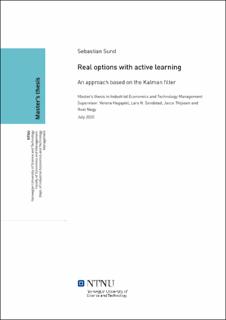| dc.contributor.advisor | Hagspiel, Verena | |
| dc.contributor.advisor | Sendstad, Lars H. | |
| dc.contributor.advisor | Thijssen, Jacco | |
| dc.contributor.advisor | Nagy, Roel | |
| dc.contributor.author | Sund, Sebastian | |
| dc.date.accessioned | 2021-09-14T17:10:14Z | |
| dc.date.available | 2021-09-14T17:10:14Z | |
| dc.date.issued | 2020 | |
| dc.identifier | no.ntnu:inspera:59706526:59721454 | |
| dc.identifier.uri | https://hdl.handle.net/11250/2777007 | |
| dc.description.abstract | Selv om tradisjonelle realopsjonsmodeller tar hensyn til usikkerheter i markedet, åpner de ikke for en beslutningstaker som aktivt søker ny informasjon for å lære om fremtidige markedsforhold. Muligheten til å lære fra omgivelsene introduserer nye betraktninger som har fått økt oppmerksomhet i nyere litteratur. Med aktiv læring tillates faktorer som tradisjonelt sett har vært antatt å forbli konstante å endre seg med nye observasjoner. Denne oppgaven utvider literaturen om realopsjoner ved å diskutere hvordan en opsjonsholder kan lære om stokastiske prosesser som utvikler seg over tid. Vi anvender et Kalmanfilter til å formulere et tidsavhengig estimat av en observert stokastisk prosess. Vi begrenser oss til lineære stokastiske prosesser med normalfordelt støy. Den resulterende estimeringsprosessen har en usikkerhet som antas å ikke kunne diversifiseres. Vi formulerer derfor opsjonsholderens forhold til risiko ved hjelp av en nyttefunksjon. Hovedformålet med denne oppgaven er å demonstrere hvordan denne metoden kan anvendes, og å diskutere egenskapene til den optimale beslutningsstrategien. Ved hjelp av et numerisk eksempel ser vi at marginalverdien av læring synker fort over tid, og at majoriteten av investeringsbeslutninger forekommer tidlig i levetiden til opsjonen, etter opsjonsholderen har realisert de største læringsfordelene. Vi viser også hvordan fordelingen av investeringsbeslutninger varierer med endringer i det opprinnelige estimatet. | |
| dc.description.abstract | Although traditional real options models are able to appropriately account for an uncertain investment environment, they do not allow the decision maker to actively seek information in order to learn about future market conditions. This opportunity to learn introduces considerations that have received increased attention in recent literature. With active learning, factors of the project under consideration that have traditionally been assumed to stay constant are allowed to change as a result of observations. This thesis extends the literature by discussing how an option holder may learn about a stochastic process that evolves with time. The Kalman filter is applied to derive a time-varying estimate of the process, and the option is valued as dependent on this estimation. We focus our attention on linear stochastic processes with normally distributed noise. The resulting estimation has a risk that is assumed to be undiversifiable. A utility model is therefore applied to model the option holder's relationship to risk. The main purpose of the thesis is to illustrate the applicability of this approach and to discuss properties of the resulting optimal strategy. With a numerical example, we find that the marginal benefit of learning decreases rapidly over time, and that the majority of exercises occur early in the option holding period, after the holder has realized the main benefits of learning. We also illustrate how the distribution of exercise times varies with changes in the initial belief. | |
| dc.language | | |
| dc.publisher | NTNU | |
| dc.title | Real options with active learning - An approach based on the Kalman filter | |
| dc.type | Master thesis | |
